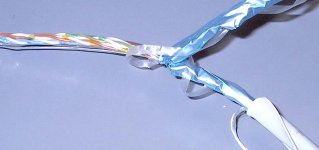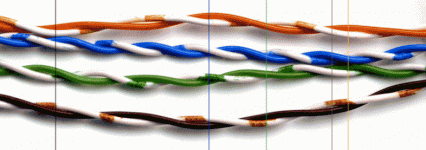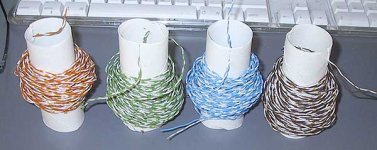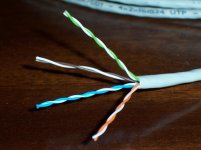SY said:I'm not sure of your construction because I'm not nearly modern enough to know how CAT5 is constructed.
A newly cyroed piece of Cat 5 with the outer sheath peeled back, otherwise untouched. Each par is twisted and then 4 pair are spiraled together. This bit has PVC insulation.
Multimedia cables S1/2000 N STX4+ Evolution - 4 pairs FTP AWG24 - ISO/IEC 11801/EN 50173 - Category 5+ extended frequency 200 MHz
I just mine it for the extraordinarily high purity 24g solid copper wire (& take advantage of the price due to people running millions of miles of it for networks)
dave
Attachments
SY,
First, Cat 5 is the cable used to connnect computers together in ethernet networks. A Cat 5 cable has 4 twisted pairs inside a sheath. Each conductor is individually insulated with plastic, strippable insulation.
The kind used for routing through plenums in buildings has teflon insulation for the outer sheath- possibly on the individual conductors too.
The conductors are usually solid single wire , but can also be made up of lots of thinner wires for use over short distances.
The preferred type it seems is the solid conductor with teflon insulation. It is available at Home Depot right next to your beloved orange w/ green stripe AC cord.
I'm using a separate bundles for v out and common (completely separate cables) but the other option is to use one of each twisted pair for vout and the other for common, all in the same cable. This would then be "higher capacitance" from what you guys have said, but I suspect not excessive... that would be 4 conductors for v out and 4 for common.
My calcs using the awg chart in the Wiki under "Amplifiers" are that a run of 8 24 ga conductors is equivalent to a 15 ga conductor in area.
First, Cat 5 is the cable used to connnect computers together in ethernet networks. A Cat 5 cable has 4 twisted pairs inside a sheath. Each conductor is individually insulated with plastic, strippable insulation.
The kind used for routing through plenums in buildings has teflon insulation for the outer sheath- possibly on the individual conductors too.
The conductors are usually solid single wire , but can also be made up of lots of thinner wires for use over short distances.
The preferred type it seems is the solid conductor with teflon insulation. It is available at Home Depot right next to your beloved orange w/ green stripe AC cord.
I'm using a separate bundles for v out and common (completely separate cables) but the other option is to use one of each twisted pair for vout and the other for common, all in the same cable. This would then be "higher capacitance" from what you guys have said, but I suspect not excessive... that would be 4 conductors for v out and 4 for common.
My calcs using the awg chart in the Wiki under "Amplifiers" are that a run of 8 24 ga conductors is equivalent to a 15 ga conductor in area.
Variac said:The kind used for routing through plenums in buildings has teflon insulation for the outer sheath- possibly on the individual conductors too.
Plenum grade has teflon insulation for the inner wires and when the building burns the teflon doesn't put out toxic fumes like PVC insulation does.
The conductors are usually solid single wire , but can also be made up of lots of thinner wires for use over short distances.
Stranded is usually used for the more flexible interconnect cables (ie wall or hub to computer)
dave
planet10 said:A newly cyroed piece of Cat 5 with the outer sheath peeled back, otherwise untouched. Each par is twisted and then 4 pair are spiraled together. This bit has PVC insulation.
Yes, that's SFTP (shielded) cat5 cable.
One of the issues is that most of these cables have different crossing on each pair (from tighter to looser), but that is not very clear on your pic, maybe your cable is not made that way?
I once tested a complete cat5 cable for interconnect, separating the whites for ground and the colour wires for +.
The sound was funny, because the bass was detatched from the rest, it had a delay.
This I attribute to the different crossing in each pair.
So I started making interconnects out of cat5 cable stripping it completely (and uncrossing) and using just 4 wires, crossed 'a la Kimber'.
For speaker cable this problem doesn't seem to be detectable, but it is better to dismantle everything and cross it by yourself.
Lots of work, though...
planet10 said:I just mine it for the extraordinarily high purity 24g solid copper wire (& take advantage of the price due to people running millions of miles of it for networks)
dave
Yes, it's cheap, and it's high purity copper.
I bought some tens of meters years ago (FTP, unshielded) and the bill was 6 €. Still have plenty.
Variac said:The conductors are usually solid single wire , but can also be made up of lots of thinner wires for use over short distances.
Solid core is for long distances, through-wall installations, etc.
The other one is just for making the small cables that you use from the network plug on the wall to your PC, because the multi-core cable is the one to use to cramp an RJ-45 plug, and the cable is also more flexible.
I worked on the field.😀
Just a note about working with Cat5 cable. Mine had a thread of fibers running with the wires. You can use the thread to split the outer insulation. Strip back enough insulation to grab the thread and pull it at a sharp angle against the outer insulation. It will split the insulation almost all the way to the other end.
I'm using a separate bundles for v out and common (completely separate cables) but the other option is to use one of each twisted pair for vout and the other for common, all in the same cable. This would then be "higher capacitance" from what you guys have said, but I suspect not excessive... that would be 4 conductors for v out and 4 for common.
You perceive correctly, your configuration has low capacitance but probably a rather high inductance. The nice thing about multis is that you can tune the relative impedances by including some Vout and Common strands within a jacket. For example, the next logical step up in C (reduction in L) would be to allow one of the four bundles in the "common" cable to carry Vout signal and vice versa for the other cable.
Or you could do it my way, which is to use an amplifier that's stable enough not to care about stuff like that.
Notice that as each pair has different crossing, some pairs have effectively much more wire length than others.
That can't be good.
That can't be good.
carlosfm said:Notice that as each pair has different crossing, some pairs have effectively much more wire length than others.
That can't be good.
You're right! This means that part of the signal arrives before another part. That is bound to torque the speaker cone. If we are not carefull, the sound will zip right past our ears instead of into them. You bet you can hear that! Or rather, not hear that. Or can we hear silence?
Jan Didden
carlosfm said:Notice that as each pair has different crossing, some pairs have effectively much more wire length than others.
Keen observation.
Attched is a scan with (approximately) a line drawn for each color after 2 twists from the black line.
dave
Attachments
janneman said:You're right! This means that part of the signal arrives before another part. That is bound to torque the speaker cone. If we are not carefull, the sound will zip right past our ears instead of into them. You bet you can hear that! Or rather, not hear that. Or can we hear silence?
Jan Didden
Jan, why are you always pulling my leg?😀
This post should not be coming from you, someone I do highly respect, although we may not always agree.
I don't blame you, this place is getting strange lately...
The pairs have different crossing, from the tightest one to the lightest one there is a big difference in length.
I didn't say you can hear it on a speaker cable, did I?
I did notice artifacts on an interconnect, as I said previously.
I don't work with this for almost 10 years, so maybe today there are some different variants.
You made me go and get my cable and take a pic.
From lighter to tighter crossing you have:
1. Brown + white-brown
2. Orange + white-orange
3. Green + white-green
4. Blue + white-blue
It may not be as clear in the pic as it is looking at the cable.
If you think this is not an issue, go and parallel several runs of wire to your speakers, from 2.5 to 5 meters.
Attachments
How big a difference is "big"? What does that come to in nanoseconds? How do the people who put high speed signals down those cables deal with it?
SY said:How big a difference is "big"? What does that come to in nanoseconds?
There are big differences in length from the ligtest to the tightest crossing, and Dave showed it quite clear with his scan.
The nanoseconds I leave to you.😀
If you know all the cable's properties...
It's not an ideal solution to use the whole cable, anyway, is it?
SY said:How do the people who put high speed signals down those cables deal with it?
For them it is probably a feature that helps reduce interference between signals on each pair.
dave
planet10 said:For them it is probably a feature that helps reduce interference between signals on each pair.
dave
Yes, I also think that's it.
Also, there are different signals on each pair.
And there is a standard for connecting the plugs, there is a standard pinout in which each colour wire goes to the correct pin.
carlosfm said:
There are big differences in length from the ligtest to the tightest crossing, and Dave showed it quite clear with his scan.
The nanoseconds I leave to you.
I
If I use your number of 2.5 meters, then assume that each strand is separately terminated rather than connected together at the far end (worst case), I get about 8 or 9 nanoseconds. I'll let the double-domes debate about how that might affect an audio signal.
Now, once the far ends are tied together, all bets are off. Using multiple strands, I am experimentally unable to see timing differences at the far end of a cable, though I admit to being limited to a 100MHz scope.
SY said:Now, once the far ends are tied together, all bets are off.
You can tie (group) all the whites and all the colours, etc.
You can tie all the whites from two or three crossed cables, all the colours, etc.
You can tie all the wires of one cable.
There are several possibilities.
yeh if you are still here check out the eminence apt50 nice loud smooth tweet and cheap tooAudiophilenoob said:
I might just try it with a simple TB 4" i have and xovered with a simple tweet
Yeh I agreeAudiophilenoob said:
oh and just because a manufacturer "specs" FR response... doesn't mean much... ALL major manufacturer's fudge things a lot... I wouldn't be happy with that unless I see RTA's he's done even in open air
Yeh everyone adds a sub they do not need... well except me...carlosfm said:
Look, I don't feel no lack of bass ON MY ROOM with these speakers.
Even without necessity, I built a sub, which goes down to (simulated) 20Hz at -6db, on a SEALED cabinet, with no EQ to boost bass.
-6 @ 20 db? who are you trying to kid? There isnt a speaker out there that will do -6 at 20hz in a tiny sealed box like that...
my 24" harts that have a fr of 20hz cant even come up with numbers like that in a tiny sealed box... lol
I dont believe you on this either but I will give you the benifit of a doubt and await to hear what kind of driver will do -6 at 20 in a tiny sealed enclosure,,,
rnrss said:-6 @ 20 db? who are you trying to kid? There isnt a speaker out there that will do -6 at 20hz in a tiny sealed box like that...
Don't you ever quit with that BS?
The box is not as tiny as you think, it's 25L, and the (dual voice coil) woofer has very small VAS and other TS parameters you'll struggle to find.
rnrss said:my 24" harts that have a fr of 20hz cant even come up with numbers like that in a tiny sealed box... lol
My woofer is much better than yours, then.😀
LOL.
rnrss said:I dont believe you on this either but I will give you the benifit of a doubt and await to hear what kind of driver will do -6 at 20 in a tiny sealed enclosure,,,
Believe or not, it's up to you.
I could provide you with all the data, but I just don't feel like.
Let's make it my little secret, then.
Cheers

carlosfm said:
Believe or not, it's up to you.
I could provide you with all the data, but I just don't feel like.
Let's make it my little secret, then.
Cheers
I guess I am pretty skeptical about those numbers. I'm assuming that you did your testing corner loaded in a small room? Have you ever tested it in real life or are you just going off simulations (corner loaded)?
- Status
- Not open for further replies.
- Home
- Design & Build
- Parts
- Speaker wire ......... Why



